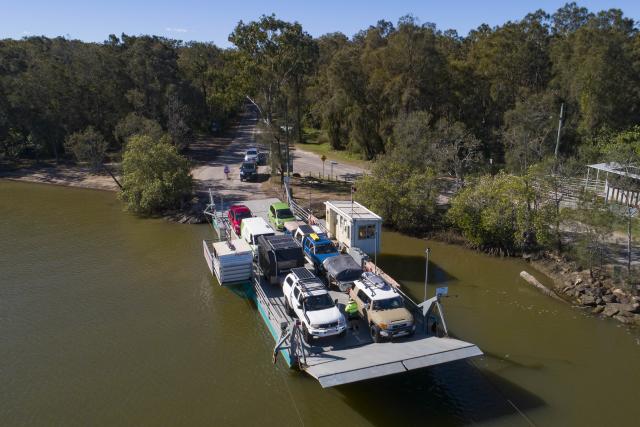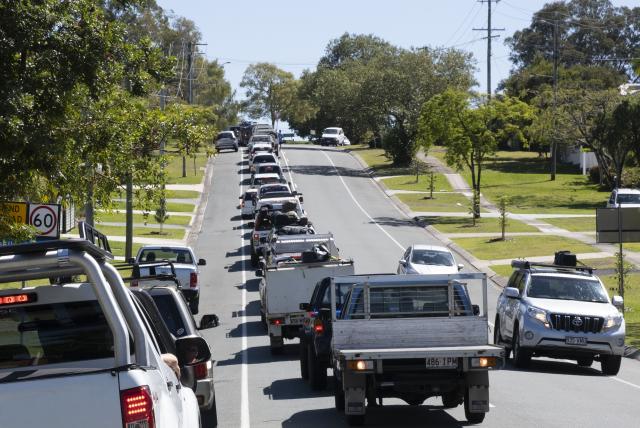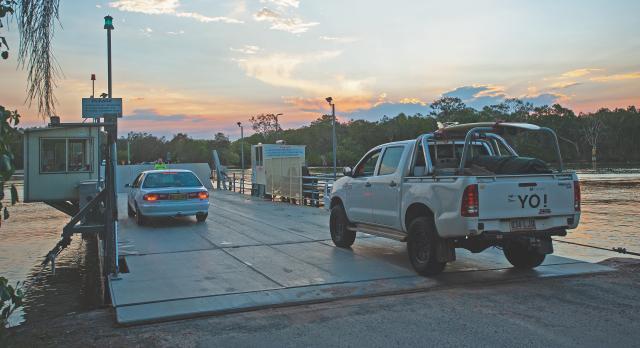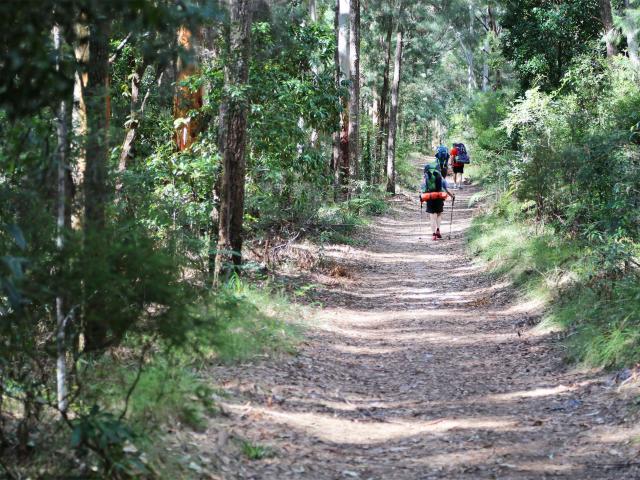Part 1: The reality
As one of the most hectic summer holiday seasons on record draws to a close, locals, councillors and stakeholders are predicting that the Noosa North Shore, gateway to the Great Sandy National Park, is at a dramatic crossroads.
Faced with peak period ferry queues that extend all the way back to Tewantin, a low tide sand highway clogged with speeding 4WD drivers which is forcing swimmers, fishermen and walkers off the beach, and camping areas littered with human waste and refuse despite new state government regulations, many families who have enjoyed their slice of paradise on the other side of the river for generations are saying enough is enough.
Some are even advocating full or part-time beach closures so that the country can regenerate and future uses reassessed.
To get to the heart of the problems facing the North Shore, there are more roadblocks than there were at the state border, in the form of commercial in confidence and non-disclosure agreements and simple, old-fashioned “no comments”, but Noosa Today dug deep and over this two-part article, we’ll examine what’s really going on now, and what a vision of the future might hold.
The ferry lease
Although there are shades of opinion over how crucial the Noosa River vehicular ferry operation is to controlling visitor numbers on the North Shore, most people agree that the current service simply doesn’t cope with the Covid era peak holiday period demand. There are also concerns that both of the ferries are not always operational when required, and that despite digital payment trials, the company still accepts only cash payment.
For over a decade, Council has operated the ferry service through a commercial lease agreement held by Noosa North Shore Ferries Pty Ltd (NNSF). In April 2019 Council considered a report recommending award of a lease extension provided for under the agreement, but decided to award a three-year extension rather the five-year extension recommended by staff, resolving that: “The remaining balance two-year extension period to be further considered prior to the lease expiry to allow Council to investigate opportunities for digital technology introduction”.
The current lease agreement is now due to expire on 30 June, five months away, with the remaining two-year extension remaining in abeyance.
In August last year Council received a report from Manager Property Clint Irwin recommending that Council agree to award the remaining two-year lease extension to Noosa North Shore Ferries Pty Ltd, and agree to consider a further report at Council’s February 2022 round of meetings “regarding proposed ferry service operating models, contractual arrangements and tender process for the purpose of proceeding to procure a new ferry service operation commencing 1 July 2024”.
While councillors can vote against the staff recommendation, five months out from expiry it is an impossibility that an alternative ferry service could be developed, so it seems that NNSF will be given two years to see to its affairs while the tendering process for 2024 kicks into gear. It is understood that Tourism Noosa board member and owner of Pelican Boat Hire and Noosa Slipways Craig McGovern plans to tender for the lease. NNSF owner/operator Cliff Andreassen declined to comment to Noosa Today this week.
A Council-commissioned report from economic consultants AEC Group on business model options for a new leasing arrangement was due late last year, but at the time of writing had not been received. Acting CEO Larry Sengstock told Noosa Today the report was expected “over the coming month”.
One veteran North Shore watcher was adamant that the only acceptable leasing arrangement would be if Council owned the operation and its assets and ran it as a public service, controlling its numbers policy and hiring an operating company for the day to day management. “But,” he added, “It’s important for the community that the ferry operation and the resident population remain detached from policing of visitor numbers.”
President of Teewah Landholders Association Paul Winter said that while he and other members he had spoken to didn’t want to see an increase in numbers of people crossing the river, “quite a few of the people who are currently heading north through Teewah on camping trips could be accommodated by an extended camping zone at the cuttings. That would mean the numbers coming over on the ferry would remain at or near current levels, which would be good for a new operator, take pressure off the environment to the north, and might not make a huge lifestyle difference. The Teewah residents would see that as a move towards a substantial reduction of numbers impacting Teewah Beach and Cooloola National Park.”
The beach highway
“We’ve just had enough,” said Kabi Kabi Native Titleholders spokesperson Brian Warner. “This is our country and now that we are in a position to care for country again, we’re going to make sure that something is done to prevent it being destroyed. We don’t need to do a trial, that was already done during the Covid lockdown, and when no one could use the beach, it regenerated very quickly. That’s all I can say.”
Brian speaks with great passion about this contentious issue, as do other Kabi elders, but like others in this story, he is bound by a non-disclosure agreement related to commercial arrangements still under negotiation. But they are not alone in the historical view that now is the time to act on preserving the North Shore.
“I think caring for country is going to become the predominant ethical driver of what happens on the Noosa North Shore,” says environmental warrior and former Noosa Parks Association president Michael Gloster. “The Kabi Kabi cared for that country for millennia through to about 1840 when they started to get frog-marched off it. The exploiters had another 100 years or so of free rein until the 1960s, when the Noosa Parks Association started caring for country by fighting for and then progressively winning a 80,000 hectare Cooloola National Park running from the northern bank of the Noosa River all the way to K’gari/Fraser Island. We’ve been at it for 60 years, and we’re not done yet. And now we have a promising development with the Queensland government signalling serious intent to have joint management of the park between QPWS and Indigenous interests.
“The beaches have been smashed. When you sit down and talk to the Kabi about it, you discover that they are really appalled by what’s happened, that’s probably their leading gripe. So they will put tremendous moral force onto their management partners (QPWS) to fix the situation on the beach, and they’ll have the power and authority to do it.”
While the Kabi Kabi have perhaps the strongest view on closing the beach cuttings to tourist traffic at least periodically, others favour capping the numbers through permits or restricting recreational beach driving to a small section, as in Teewah landholder Paul Winter’s suggestion that they be restricted to an extended camping area south of the third cutting. It’s important to note that while Covid crowds have exacerbated the problem, it is not new.
Former Noosa mayor Tony Wellington established the Teewah and Cooloola Working Group in September 2018. He says: “Its formation was a direct response to concerns raised about the impacts of visitors accessing Teewah Beach within the Cooloola section of The Great Sandy National Park for both recreational beach driving and also camping. This included media-reported incidents during peak holiday seasons of vehicles driving on the dunes, as well as other issues regarding overcrowding and waste disposal.”
Although the primary focus of the large group drawn from both Noosa and Gympie was to improve management of the natural environment in the face of a tourist invasion, Tony says: “Primary to these discussions was the issue of visitor experience and a desire to enhance that experience whilst reducing environmental impacts.” In other words, the amenity of residents and the visitor experience can work hand in hand. Let’s face it, if your kids nearly get run over by bogans doing donuts on the beach and your campsite stinks of excrement, you’re probably not going to come back next holidays.
Speaking of which, since 12 October last year all campers in the Teewah Beach camping zones have been required to bring and use a portable toilet for the duration of their stay. This new requirement was considered the best answer to the issue of high levels of bush toileting occurring at Teewah Beach, particularly during peak times, contaminating the environment and posing an unacceptable health risk to campers and visitors. Constructing permanent toilets is not feasible as shifting sands and tidal influences make it impossible to erect permanent structures.
Queensland Parks and Wildlife Service (QPWS) installed a $576,000 portable waste disposal facility at second cutting to assist campers with the new requirement, making it easy for them to dispose of their waste before heading home. From 12 October, it has been an offence to camp in this area without a portable toilet, with an on-the-spot penalty of $413 applying for offenders, but there have been reports all season of campsites smelling like a sewer and campers emptying their portables into holes dug in the sand dunes. So Noosa Today asked QPWS (via the Department of Environment and Science media office) how many fines had been issued. Answer: none.
“While using portable toilets in the Teewah Beach camping zones is now mandatory, rangers will focus on education rather than compliance over the coming months,” a spokesperson said.
The Great Walk
Not quite a year ago Noosa Today got quite excited about the realisation of Queensland’s first commercial eco-tourism trail, right on Noosa’s doorstep.
“The development of the Cooloola Great Walk is poised to begin its construction phase, with a consumer roll-out projected for the end of this year or early 2022,” we noted enthusiastically. “And for once, all of the stakeholders, from developers to eco-warriors, from tourism bodies to First Nations, seem to be on the same page.” Well, not quite.
Key to the apparent unity over the walk was Noosa Parks Association softening its position in a letter to members: “Our management committee’s preference has been for the Cooloola Great Walk to remain a fully DIY experience. We believe the greatest threat to the natural values of Cooloola are ever-increasing visitor numbers and resulting impacts … At the same time, we are aware that commercially supported multi-day national park walks are becoming increasingly available and popular around the country, including with our own members. We believe that what is required is a systematic and concerted government commitment to manage visitor numbers and impacts in an integrated fashion, making sure that the impact on the environment is low.”
In 2019, under its Queensland Ecotourism Trails program, the government called for expressions of interest to design, build and operate a supported Cooloola Great Walk. There were three short-listed applicants, including Tourism Noosa, and in late February, 2020, the tender was awarded to Adelaide-based CABN, a company specialising in “eco-friendly, off-grid, nature-based accommodation”. Noosa Parks Association supported the selection, but 11 months later some senior board members are dubious that the partnership between the Indigenous interests, QPWS and a commercial tourism operator can work.
Said one: “The Kabi position has changed over time since the expressions of interest were requested and NPA supported CABN over Tourism Noosa. (CABN CEO) Michael Lamprell was brilliant in his dealings with the Kabi but the negotiations appear to have stalled. Meanwhile the conservation movement is going nuts over the prospect of infrastructure going into a national park. It’s really a small amount of infrastructure in a big park, so it’s nothing compared with the issues on the beach, but that is another factor.”
Others say that the business model is simply not workable. Since the plan has always been that the new high-end commercial Great Walk would operate side by side with the existing five-day “DIY” trail, with the latter going through delicate and beautiful sites that will not allow vehicle access for servicing, punters would have a choice of exploring the wilderness carrying their own pack and cooking for themselves for $5.95 a night, or going business class with a valet carrying your pack and a glamping bed awaiting you every night for roughly $500 a night.
Says Cr Tom Wegener: “The idea of a small number of people going glamping on the North Shore is the direct opposite of encouraging more and more people to drive up the beach. The Kabi have been behind the glamping because they see it as a foot in the door, an involvement in a business that looks after their land while making some money off it. The problem is if that’s the business plan it’s going to collapse.”
Noosa Today was unable to contact Michael Lamprell for comment.
NEXT WEEK: THE NORTH SHORE DREAM











